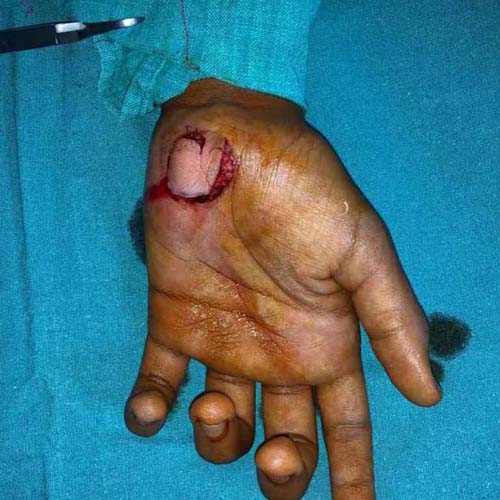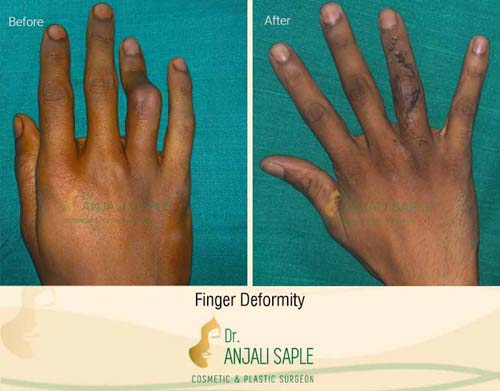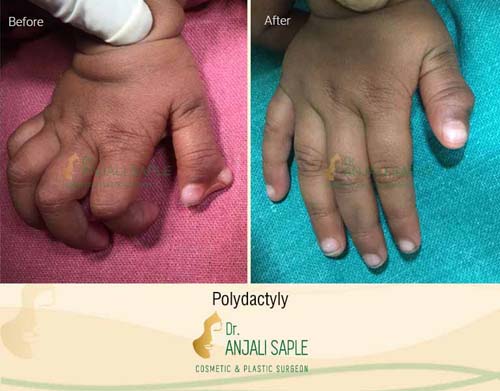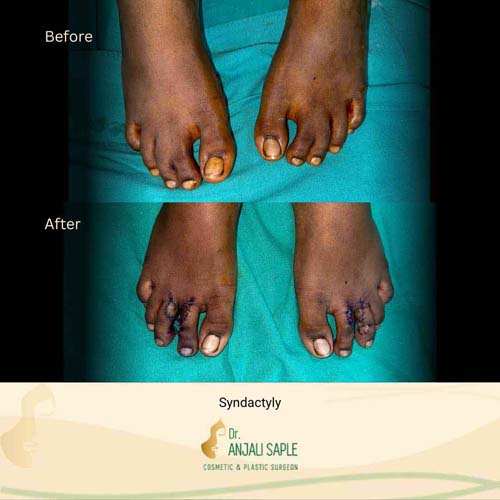Transform Your Functionality
Expert Hand Reconstruction Surgery
Dr. Anjali Saple offers personalized Hand Reconstruction Surgery to restore your hand's functionality and appearance.
- Restored mobility and strength
- Improved hand aesthetics
- Enhanced quality of life
- Personalized care tailored to you
I had an excellent experience with Dr. Anjali Saple Madam during my father’s surgery (A Ramarao). She approached his treatment with great care and expertise, and we were amazed by how quickly he recovered. His finger injury, which was got complicated due to diabetes, was handled exceptionally well. Thanks to Dr. Anjali's experience , my father is now doing much better. We are truly grateful for her support and the positive outcome. I Highly recommend her. -- By Kishore Annam
Understanding Your Struggles
Hand injuries or deformities can drastically affect daily life.
Struggling with pain, limited mobility, and the emotional toll of a disfigured hand can leave you feeling frustrated and hopeless.
The Best Treatment Option
Comprehensive Hand Reconstruction Surgery
Dr. Anjali Saple specializes in Hand Reconstruction Surgery, focusing on restoring both function and aesthetic to your hand. Her patient-centered approach ensures that each treatment plan is customized to meet your specific needs and goals. Utilizing advanced surgical techniques, she effectively addresses injuries, deformities, and other complications, resulting in lasting improvements.
Why Choose Us
Dr. Anjali Saple’s Unique Approach
With over 25 years of experience, Dr. Saple brings unmatched expertise and compassion to her practice.
25+ Years of Experience
Dr. Anjali Saple has extensive knowledge and skills, ensuring optimal outcomes for her patients.
Personalized Treatment Plans
Every patient receives a tailored plan to address their unique situation and health goals.
Award-winning Specialist
Recognized by multiple professional organizations, she is a trusted leader in the field of plastic surgery.
FAQs
Your Questions Answered
It can help with injuries, congenital defects, and post-traumatic deformities.
Recovery timelines vary individually, but standard healing can take 6-12 weeks.
While every surgery carries risks, Dr. Saple will discuss all potential complications during your consultation.
Costs vary based on complexity; a consultation can provide an accurate estimate.
Most patients benefit from physical therapy to regain maximum functionality.
Typically, yes, but your anesthesia plan will be customized for your procedure.
We will provide specific instructions on preoperative care during your consultation.
Got More Questions?
Contact us to get all your queries resolved and book your consultation.
Key Benefits of Surgery
What You Can Expect
Improved Functionality
Enhanced everyday tasks and activities through improved hand strength and mobility.
Aesthetic Restoration
Surgical techniques that enhance the appearance of your hand, bringing back confidence.
Comprehensive Care
Continuous support throughout your recovery process, ensuring you heal effectively.
Safe and Effective Techniques
Using advanced methods that prioritize your safety and minimize recovery time.
Customized Recovery Plans
Each patient's recovery plan is tailored to their specific lifestyle and needs.
Multilingual Support
Care provided in English, Hindi, and Telugu, ensuring clear communication.
Patient Transformations
See the incredible results our patients have achieved.
Patient Success Stories
Hear from our patients about their transformative experiences with Dr. Saple's care..
Getting Started
Three Simple Steps to Recovery
Initial Consultation
Meet Dr. Saple for a thorough assessment and detailed discussion of your condition.
Personalized Surgical Plan
Receive a customized treatment plan tailored to restore your hand functionality and aesthetics.
Follow-Up Care
Enjoy ongoing support and follow-up visits to ensure a smooth recovery and optimal results.
Addressing Your Concerns
We understand the hesitations surrounding surgery, and we’re here to help.
Dr. Saple uses proven techniques with high success rates, and we ensure thorough assessments prior.
Every surgical procedure has risks. Dr. Saple will explain these in detail during your consultation.
We offer flexible pricing options, and your financial concerns can be part of our discussion.
Still Have Questions?
Reach out to us to discuss any further concerns you might have.
Your Future Awaits
Take the step to restore your confidence.
Expert Care for Your Hand
Hand Reconstruction Surgery by Dr. Anjali Saple
Providing compassionate, patient-centered care for over 25 years in Vishakhapatnam.




